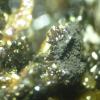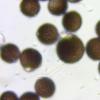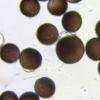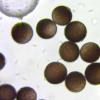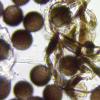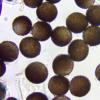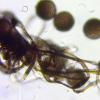
31-10-2025 09:19
 Lothar Krieglsteiner
Lothar Krieglsteiner
Can somebody provide me with a file of:Rogerson CT

09-08-2025 13:13
 Maria Plekkenpol
Maria Plekkenpol
Hello,Yesterday I found these on burnt soil. Apoth

28-10-2025 19:33
 Nicolas Suberbielle
Nicolas Suberbielle
Bonjour à tous,Je voudrais votre avis sur cette r

25-11-2016 13:54
 Stephen Martin Mifsud
Stephen Martin Mifsud
Hi, I found numerous seeds of Washingtonia robusta

28-10-2025 22:22
 Bernard Declercq
Bernard Declercq
Hello.I'm searching for the following paper:Punith

28-10-2025 15:37
Carl FarmerI'd be grateful for any suggestions for this strik

28-10-2025 11:29
 Tanja Böhning
Tanja Böhning
Hello, I found this very small (ca 0,5mm) yellow
 ... of Picea in the Eifel, about 550 m NN, together with Lachnellula resinaria and Lophium mytilinum. The black "mould" builds spores of about 15-20 (25) µm which show the colour assymetrically. Who can provide me with a name?
... of Picea in the Eifel, about 550 m NN, together with Lachnellula resinaria and Lophium mytilinum. The black "mould" builds spores of about 15-20 (25) µm which show the colour assymetrically. Who can provide me with a name?Best regards, Lothar



LG, Lothar


first: thanks for your response!
Well - you really make me think, especially, because already Zotto made the same (not so detailed) proposal.
But - I still doubt, and I will explain why.
I saw only a thin fluffy film of spores on the resin, on the resin, and quite flat, spread out on a surface area of about some mm in each direction . There was no hint of a squashed sporocarp or something elsle of a myxo, and I must admit, I did not htink of a myxo at all, even not after preparing (and I also admit that it is reaonable to think in this direction). When looking for structures of an anamorph, I did not find much, only what I showed, and it is right, there are no septa to be found, and the ornamented spores are round. The large spores, fuirthermore, were not comparable to a myxo I know (maybe without Amaurochaete, but this is large and surely would have contaminated more of the resin and leaved a lot more remains, would have contaminated the nearby fruting Lalchnellula for instance). O.k. - Diacheopsis. I never (!) found a sure Diacheopsis, all species of the genus are rare or at least very rarely found.
So - for me it is still more reasonable to have an unclear anamorph whose structures I did not prepare well, as such a rare myxomycete. Perhaps you should know that I have worked with myxomycetes since I was a boy, and for instance published two new species in this group (Arcyria riparia, Fuligo luteonitens). But - maybe you are right and it is Diacheopsis insessa. Very strange ....
Best regards, Lothar
Saludos cordiales.
Josep

thanks for you, too.
I think I have embarassed myself terribly (maybe not for the first time ..).
Best, Lothar


here it is: lkrieglsteiner@t-online.de
You can also find it if you click on my name in every contribution.
I am glad to receive your paper.
Best regards, Lothar


thanks a lot for your file - very impressive work!
In fact, Diacheopsis insessa as shown by you seems to be easy to overlook, and it seems to be very likely my "fungus" - and it seems to fit also ecologically. Unfortunately, I did not look further at the findplace - and there is no material left. So - try again, maybe next year ... (I do not come to the Eifel mountains earlier).
Best regards and thanks again,
Lothar

I second the oppinion of Zotto and Edvin.
This is, imho, clearly a species of Diacheopsis, either, as proposed
by Edvin D. insessa, or a taxon, which I have found regularly during
the last ten years in Denmark, and which has recently been located in
Northern France as well.
You can find descriptions of the French specimens of this Diacheopsis
sp. at Bernard Woerly's website: http://myxosdesvosges.org/?fiche=153
and of the Danish ones at my web: http://www.myx.dk/spp/dissp1.html
Is is true, that the species of Diacheopsis are rarely met with,
most seem to be nivicole. But the danish taxon is common (sic!),
provided the right habitat and time of year, and moreover, it seems
to be "standortstreu". During mild and moist winters it occurs on
wounds on Picea abies trunks made by red deer. No snow involved,
cryophilous would be the right term to fix at it. If Lothar's find
is related to this species, it is no wonder, that by now it seems to
be worn down.
Best regards
Henrik

thank you very much for your very interesting contribution. Wounds of the tree made by red deer - this is well possible at my findplace. Red deer and other vertebrata (wild boar, roe deer) are very present in the Eifel National Park, more than can be regarded as good.
Best regards, Lothar

joseptorresparellada@gmail.com
Muchas gracias de antemano.
Saludos cordiales

Saludos cordiales.
Josep.



very nice! I also found it twice in my region with fresh material in the meantime. Did you tell the news to Henrik F. Gøtzsche? You should, because he is preparing a paper, likely with the description as a new species momentally, together with Bernhard Woerly, Martin Schnittler and others. Your find should be included in this paper.
Best regards, Lothar


